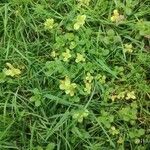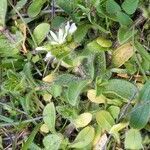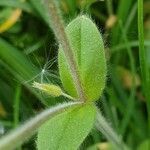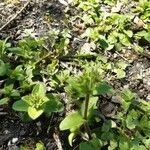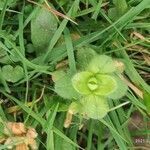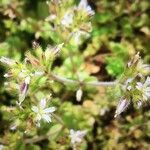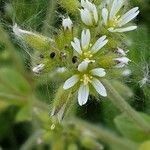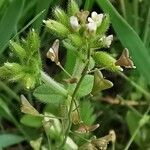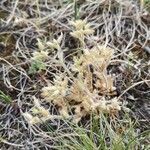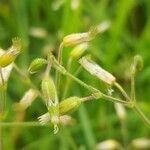Plants annual, with slender taproots. Stems erect or ascending, branched, 5-45 cm, hairy, glandular at least distally, rarely eglandular; small axillary tufts of leaves absent. Leaves not marcescent, ± sessile; blade 5-20(-30) x 2-8(-15) mm, apex apiculate, covered with spreading, white, long hairs; basal with blade oblanceolate or obovate, narrowed proximally, sometimes spatulate; cauline with blade broadly ovate or elliptic-ovate. Inflorescences 3-50-flowered, aggregated into dense, cymose clusters or in more-open dichasia; bracts: proximal herbaceous, distal lanceolate, apex acute, with long, mainly eglandular hairs. Pedicels erect to spreading, often arcuate distally, 0.1-5 mm, shorter than capsule, glandular-pubescent. Flowers: sepals green, rarely dark-red tipped, lanceolate, 4-5 mm, margins narrow, apex very acute, usually with glandular hairs as well as long white hairs usually extending beyond apex; petals oblanceolate, 3-5 mm, rarely absent, usually shorter than sepals, apex deeply 2-fid; stamens 10; styles 5. Capsules narrowly cylindric, curved, 7-10 mm; teeth 10, erect, margins convolute. Seeds pale brown, 0.5-0.6 mm, finely tuberculate; testa inflated or not.
Herbs annual, 10--20 cm tall. Stems simple or caespitose, densely villous, distally glandular pubescent. Proximal leaves spatulate; distal leaves obovate-elliptic, 1.5--2.5 × 0.5--1 cm, base attenuate into a short petiole, both surfaces villous, midvein prominent, margin ciliate. Inflorescence of compact, cymose clusters (glomerules); rachis densely glandular pubescent; bracts leaflike, ovate-elliptic, densely pubescent. Pedicel 1--3 mm, densely pubescent. Sepals 5, lanceolate, ca. 4 mm, abaxially densely long glandular pubescent, margin narrowly membranous, apex acute. Petals 5, white, oblong, subequaling or slightly longer than sepals, base pilose, apex 2-lobed. Stamens shorter than sepals. Styles 5. Capsule cylindric, subequaling or 1.5--2 × as long as calyx, 10-toothed. Seeds brown, compressed triangular, tuberculate. Fl. Mar--Apr, fr. May--Jun.
Annual, with all branches reproductive. Stems erect or ascending, (5)-10-30-(50) cm tall, with spreading eglandular and shorter glandular hairs. Lvs elliptic to broadly obovate-spathulate, (5)-10-25-(30) × (2)-5-10-(15) mm, the lower narrowed gradually to base; hairs eglandular. Infl. compact; peduncles elongating at fruiting but pedicels always = or < calyx; peduncles and pedicels densely hairy with long eglandular and shorter glandular hairs. Bracts elliptic to obovate, always herbaceous, with dense glandular and eglandular hairs. Sepals (3.5)-4-5-(6) mm long, with narrow scarious margins, and glandular and long eglandular hairs overtopping apex. Petals slightly > or = sepals. Styles 0.5-0.8 mm long. Capsule cylindric, 2× length of calyx. Seeds 0.3-0.5 mm long, tuberculate.
Annual herb. Stems ascending to erect, patently hairy with some glandular hairs intermixed, 5-30 cm. Leaves light green or yellowish green, lower ones obovate-spathulate, higher ones elliptic to obovate, obtuse or acute, pilose. Inflorescences many-flowered, congested when young, later more lax; bracts completely herbaceous; pedicels 1-3 mm, glandular scarious, in fruit elongating to 6 mm, pilose. Sepals 3-5 mm, oblong-narrowly elliptic, with or without a scarious margin, glandular-pilose and with a tuft of long eglandular hairs at apex. Petals 3.5-4 mm, rarely longer and rarely absent, claws with a few cilia. Capsule 6-8 mm, opening by teeth with revolute margins. Seeds pale brown, finely tuberculate, c. 0.5 mm.
Herb, annual, with branched tap root, and glandular and eglandular hairs. Stems slender, erect or decumbent, 5–45 cm long. Leaves sessile, obovate, elliptic or ovate, 5–25 mm long, 3–18 mm wide, hairy. Inflorescence rather dense; bracts entirely herbaceous. Flowers 5-merous, 4–5 mm diam.; flowering pedicels shorter than capsule; fruiting pedicels much longer than capsule. Calyx glandular-or rarely eglandular-pilose. Sepals 3–5 mm long, 1–1.5 mm wide, lanceolate, narrowly acute, with narrow, scarious margins. Petals ± equalling sepals, ¼ bifid, rarely absent. Styles 5. Capsule 6–10 mm long, narrowly cylindrical, curved. Seeds 0.4–0.5 mm diam., pale brown, finely elongate-tuberculate.
Has been recorded by several collectors from Tanganyika: Lushoto District, near Amani, as an adventive. It is morphologically related to C. octandrum [Hochst. ex] A. Rich. from which it differs especially in having the lower (and rarely all) flowers without petals (nearly always); petals with generally a ciliate claw; sepals more glandular; stamens often only 5; placenta not branched or radiate; seeds 0.5 mm. in diameter. A standard specimen is: Verdcourt 301, in a drain around building with Ageratum, Galinsoga, Chloris, Oxalis, Pilea, and Drymaria, 1 Aug. 1950!
Leaves opposite; basal leaves oblanceolate to obovate, narrowed into a petiole c. 4 mm. long; stem leaves 0·5–2·5 × 0·3–0·8 cm., sessile or subsessile, broadly ovate to elliptic-ovate or elliptic, apex acute or obtuse, mucronate, base cuneate, with long silky hairs on both sides.
Flowers in terminal, dichotomous, cymose clusters; pedicels glandular-hairy, very short or occasionally reaching 5 mm.; bracts lanceolate, herbaceous, hairy, similar to the upper leaves but smaller.
Petals white, often absent on the lower flowers or rarely all absent, ± equalling or somewhat shorter than the sepals, bifid c. 1/4of the way down, claw somewhat ciliate.
Capsule up to twice the length of the calyx, subcylindric, shortly stalked, slightly curved, opening by 10 blunt, apical teeth.
Sepals 5, c. 5 × 1 mm., narrowly lanceolate, very acute, green with white scarious margins, glandular-hairy outside.
Annual herb with straggling, ascending stems up to 45 cm. long, glandular-hairy at least above.
Seeds numerous, 0·5–0·75 mm. in diam., pale brown, with concentric rings of minute tubercles.
Ovary ovoid, glabrous; styles 5, c. 0·5 mm. long, free.
Stamens 10 or often only 5, c. 2 mm. long.
